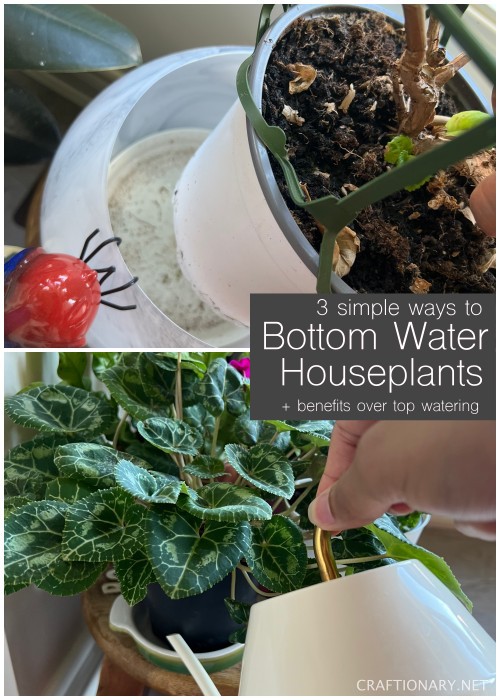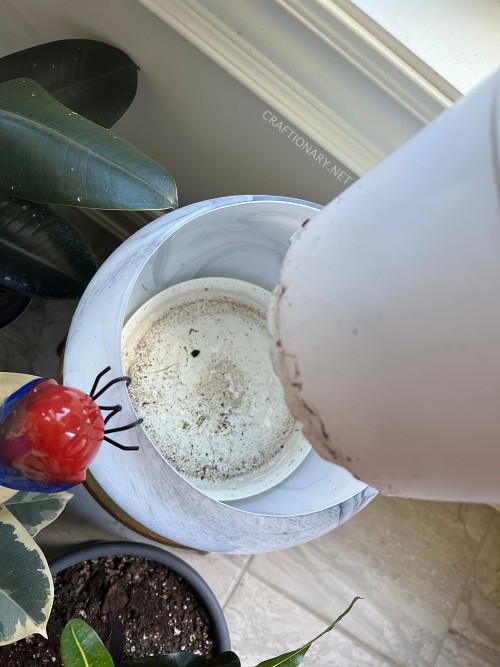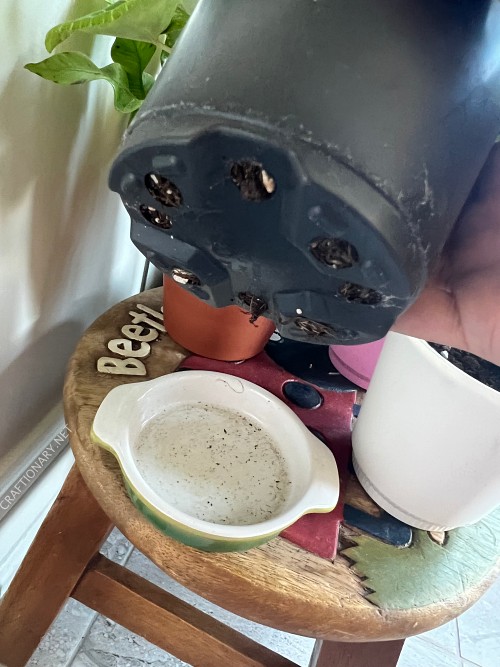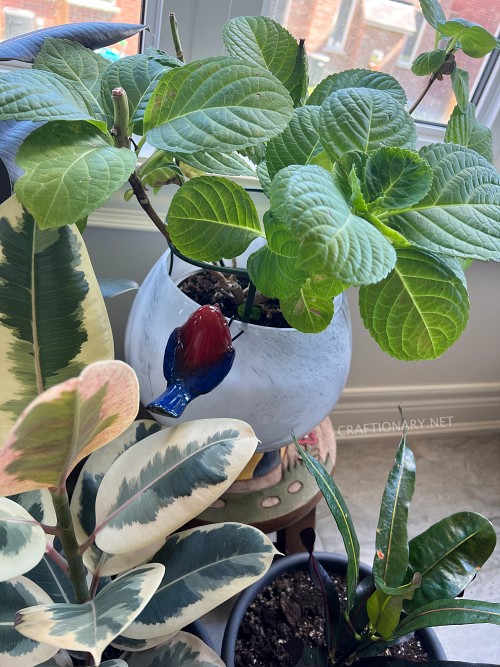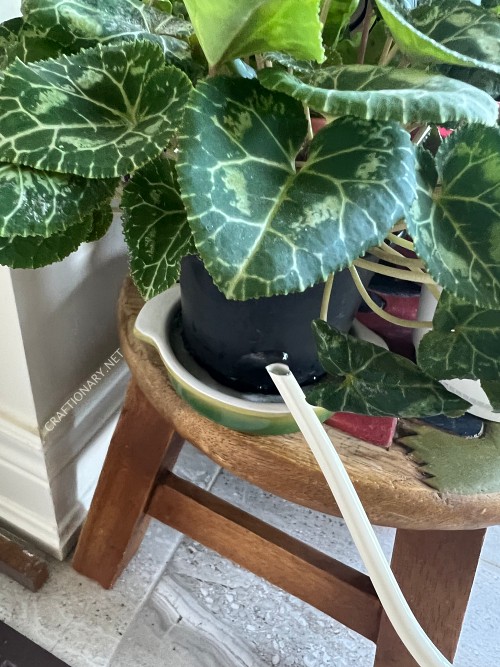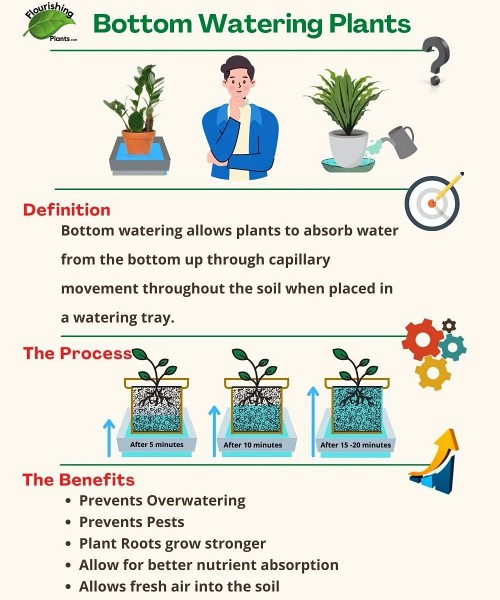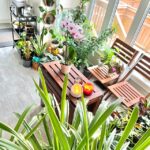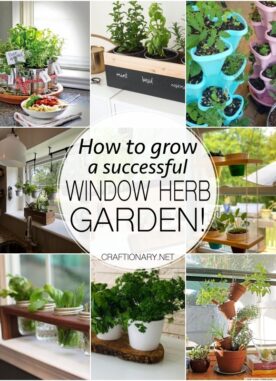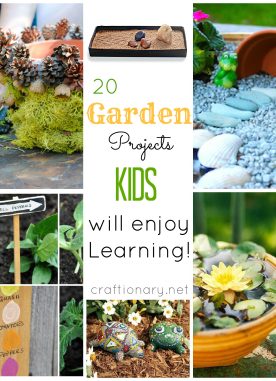This post may contain affiliate links. Please see our full Disclosure Policy for details.
Water makes 85-90% of the plant’s weight. Watering the potted plants is the most crucial part of growing an indoor garden. Two methods are used to water plants, i.e., top watering and bottom watering. While the latter is less commonly used, we will talk about the benefits and ways how to bottom water plants and keep them moist.
Top watering reduces the excess salt and mineral formation while bottom watering keeps the soil evenly moist. Bottom watering also reduces fungus gnats and prevents root bound. Using the two methods together leads to the healthiest growth of plants.
Garden soil needs one inch of water every seven days to ensure efficient water absorption by plants. To avoid slow growth and dryness regularly water your houseplants. Many problems are reduced by maintaining a healthy soil structure. Plants need two inches of water per week in a hot environment and less in a cold environment.
What is bottom watering?
The term is self-explanatory meaning that you water the plants from the bottom of the container instead of the top. This method allows the plant to soak water from the roots and maintains uniform moisture. However, you might have to wash away excess of salt and mineral deposits on the top layer of soil once a month by running water over the top of the pot.
How to bottom water plants?
How to bottom water plants method 1:
Timing is the key to watering plants from the bottom. Place a container or plate larger than the pot underneath it to hold water. Make sure you have drainage holes in the pot. Fill the container 3/4 with distilled water or filtered water. I use tap water, but some people say it has too much chlorine and can damage plants in large doses. Let the water sit there and allow the plant to soak for 10 minutes. When the plant absorbs the water, you can refill it and allow 10 more minutes as it keeps soaking the moisture from the bottom. Remove any excess water.
How to bottom water plants method 2:
The method I personally use to reach optimal moisture levels and maintain it is to bottom water the plants every day in the morning. It readily absorbs water as I fill the plate. I refill it twice or three times till the water soaking is reduced to slow signaling that it no longer is thirsty for more.
How do bottom watering plants work?
Pay close attention to the following to ensure the bottom water method works:
- Drainage holes in your planter to suck water.
- Soil is not compacted and is of good quality allowing a proper soaking environment for the plant. The degree of water absorption is different for each type of soil. For example, cactus soil has more rock and perlite, and it won’t absorb a lot of water.
- A large bowl, container, saucer, or plate to place the pot. A rule of thumb is to look for a 1-inch larger diameter for the container from the pot.
- Fill it with water and allow the plant to sip water from the drainage holes. Continue adding water till it no longer dries on the bottom plate after 20 minutes. Remove the excess water.
- If the topsoil is moist wait till it dries to water again.
- Over soaking the plant from bottom watering can lead to over watering and root rot in some cases.
There are three simple and easy ways you can use to bottom water houseplants that I personally use at home for a year and a half and my plants are thriving.
1. IKEA plastic plate bottom watering
Place the IKEA plastic plate or any plate that is about 1-2 inches in height inside your beautiful vase to water the plants. You can top water using this method as well. However, bottom watering allows the plant to be in-charge of the amount of water in requires. I have my hydrangea potted plant indoor facing morning sun utilizing the bottom watering method. It thrives in this situation.
How to water bottom up potted plants?
Make sure there are drainage holes under the pot so that the plant can soak water from the water source beneath. Hold and remove the planted pot from the vase and fill water in the plate inside the vase using a watering can. Now place the pot back on the tray allowing it to soak water from roots.
How often should you bottom water your plants?
I water it everyday filling the plate till top and letting it soak water. When I see the top soil is saturated I skip a few days till it is dry again. This method is also great for self watering plants if you plan to go away for a week.
Advantages of closed bottom watering system
- The advantage of using the bottom up watering inside a vase is it prevents attracting mosquitoes and gnats by keeping the water source hidden from outside.
- In situations where you have gnats problem and want to sprinkle diatomaceous earth on top of the soil. You can prevent the powder from water and allow it time to work on the soil’s top surface while keeping the water needs of the plant covered from the bottom.
- It looks beautiful and adds to the beauty of your indoor potted garden.
2. Ceramic plate bottom watering
Use beautiful ceramic plates, trays etc that is half an inch larger in diameter from your pot with drainage holes. I use ceramic plate bottom watering with Cyclamen. I water it everyday filling the plate till top allowing it to soak the water. This method is great for self watering while you travel for a long weekend i.e. 2-3 days. In such cases, you can fill it once letting the plant soak the water and refill a second time to leave water reserve for the plant to drink when it requires more water.
Note: Please note that plants are more active during summer and above shared findings and experience is based on summer months. In winter, plants are less active and require less frequent watering. This makes bottom watering plants an effective method to reduce frequency of watering plants while keeping them moist.
3. Bathtub or sink bottom watering
You can fill a sink or tub with water and bottom water lots of plants together in it. Let them rest in the water for 15-20 minutes allowing them to soak the required water. You can then put them back on their drainage plates and enjoy the moisture they just gathered. This method is efficient for apartments or ground floor homes. If your garden and sink require staircase it might be too much work for you.
infographic by flourishing plants.
Check out: 35 Vertical plant walls and gardens with design instructions
Advantages of bottom watering plants
When you bottom water correctly this method is suitable for all potted plants whether indoors or outdoors. Once you master bottom watering your plants will be growing in a healthier environment utilizing less time and effort. The benefits of bottom watering plants include:
- Roots of super dry plants can efficiently reach moisture allowing us to understand how much they require till we stop watering them.
- It is no longer a game of choosing how much is enough for your plant. Hence, the chances of overwatering your plants are greatly reduced.
- Plants control the water intake they require as they sit in the water underneath for them to soak up rather than pour from the top.
- Bottom watering encourages a stronger root system by attracting the roots down towards the moisture.
- It ensures even moisture in the pot as it travels from bottom to top. This way you know the water is reaching everywhere when you push your finger into the topsoil, and it is moist.
- A variety of plants are sensitive to water drops on their leaves like an African violet, Orchid, or Cyclamen. They get spots or become discolored. These plants enjoy bottom watering.
- When you water from the top your plants may become root bound allowing them to not soak any water and the moisture may run directly down from the sides through drainage holes. Bottom watering is more efficient in eliminating this problem.
- The soil is not packed with water reducing the chances of attracting pests, fungus gnats and mosquitoes. If you have this problem, switch to bottom watering, and see for yourself how it benefits your indoor garden.
- You can pour diatomaceous earth and keep it dry while maintaining proper watering of your plants to reduce fungus gnats. This is my personal tried and passed test.
- You can leave excess water as a water reservoir to work as self watering planter while you are away for a week.
- Allowing seedlings to receive moisture from the bottom up is practical and sophisticated. During the growth, it doesn’t displace delicate seedlings and allows uniform moisture absorption.
You will also like: 50 Fast growing plants for privacy to best screen backyards
Disadvantages of bottom watering plants
Plants that are sensitive to excessive salt and minerals should not be bottom watered.
- You will have to rinse the soil from the top with a good water wash once a month to remove excess of salt and minerals accumulation as bottom watering doesn’t flush them out. This leads to root burns and potential weakening of roots. It can also hinder water absorption.
- Tap water is used to water houseplants by many people and it has chlorine and hard minerals. Some experts recommend watering from the top every three months while others recommend once a month to prevent these deposits from building up.
- The salt and minerals buildup can damage your plants by reducing the absorption of the required water.
- It takes longer for the plants to soak water and may require some patience to learn to water this way.
- Some plants may require frequent watering when bottom watered to maintain their moist level. You may need to set a timer if you are forgetful.
- Plants that love water will require too much frequent watering in the bottom watering method. They like moist soil like monstera and pothos. You may want to water them from the top once a week and keep them in more watery soil.
- You can add liquid fertilizer or water-soluble fertilizer to bottom watering, but it works more efficiently in top watering.
- Excess water in bottom watering can prevent oxygen from reaching the roots by filling the spaces with water moving upward in the soil.
- Large pots will take too much time to absorb the water making it very time-consuming to water them. You can remedy it by using a larger water reserve.
- Plants in terra cotta pots are harder to water with the bottom watering method as the pot soaks water making it hard to find the right balance for the plant eventually leading to overwatering, root rot, and mushy or weak roots.
Check out: DIY indoor planter box idea with IKEA plant stand flower box
Best houseplants to bottom water plants
Best plants for bottom watering include small and medium-sized plants that have small water needs. Bottom watering is not ideal for large and tall plants.
- African violets and cape primrose do not like water on their leaves. They produce beautiful blooms.
- Root-bound plants that are so compact that the soil cannot soak enough water benefit from bottom watering.
- Watermelon peperomia and piggyback plants do not like wet leaves and love bottom watering
- Cyclamen
- Dragon tree
- Fiddle leaf fig
- Pothos
- Yucca
- Cissus
- Spider plant
- Ponytail
- Snake plants that require low light and maintenance
- Seedlings get easily displaced by water force, bottom watering keeps them moist and undisturbed during the growth stage.
Fun ideas How to display plants indoor? (42 DIY Projects)
FAQs how to bottom water plants?
Can bottom watering work for all types of plants?
Bottom watering can work for all types of potted plants that can absorb and release water efficiently. Use of good soil is recommended.
How Long Does Bottom Watering take?
The duration of bottom watering depends on several factors, such as the plant’s type, size, soil condition, and type of pot. However, the general rule of thumb is to place the plant in a container with water that reaches 1 to 1.5 inches above the bottom of the pot for about 10-15 minutes.
How often should you bottom water plants?
An effective technique to water the plants is bottom watering. It prevents overwatering if you follow a schedule to water. For example, a plant that requires watering every day should be watered every day in the morning at 9 am. For other plants, you can bottom water every three to four days.
How frequent should I water plants from the bottom?
You can check the moisture level in a potted plant by pushing your finger into the soil from the top or using a dry wood skewer to 2 inches below the soil level. If it comes out dry it’s time to water the plant.
Why is watering from the bottom not working?
In a soil mix that is very compact or has too much clay, bottom watering plants will not work. It might also not work if the tray is tilted or has very little water.
Can I bottom water large potted plants?
Yes, you can bottom water large potted plants, but it will require more time, or you can use larger containers to fill water and let the plant soak water for 15-20 minutes. You can also fill your sink or bathtub and let it soak water from below. However, if it is too heavy to move it is not ideal for bottom watering.
Where can you bottom water your plants?
You can bottom water your plants in many places such as the bathroom, bedroom, living room, etc. For example, bottom water Kimberly Queen Fern in the bathroom as the plant loves humidity and soaks up air pollutants. They also absorb airborne toxins found in drywall and paint.
Can you use a fertilizer with bottom watering?
Use liquid fertilizer or water-soluble fertilizer that dissolves well into the water to bottom water plants. This will provide the necessary nutrients to the plant’s roots and avoid clump formation or nutrients sinking to the bottom resulting in fertilizer not reaching the plant.
Do fungus gnats attract to bottom watering?
Bottom watering helps prevent fungus gnats and keeps your indoor garden clean. It can also reduce fungus gnats if you have this problem.
Can bottom watering plants work in terracotta pots?
Terracotta is porous and can absorb water. You can bottom water plants in terracotta pots with drainage holes, but it may take longer than with plastic or ceramic pots.
Can bottom watering result in overwatering of plants?
Overwatering can happen if the plant is sitting in the water for too long in bottom watering. Make sure to check on the plant every 10 minutes after watering to prevent overwatering and root rot. It is still the more controlled method of watering your plants.
Can bottom watering result in root rot?
Roots can become mushy and break off easily if they have received too much water from the bottom watering. This makes it harder to bottom water large plants as they can take more time to absorb moisture.
